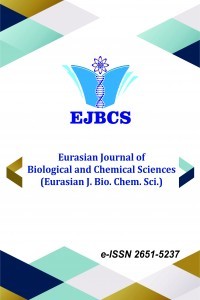Investigation of Nanoparticle Use in Geopolymer Production
Investigation of Nanoparticle Use in Geopolymer Production
Geopolymer nanoparticle, alumina,
___
- ASTM C109 2005. Standard test method of compressive strength of hydraulic cement mortars (using 2-in. or [50 mm] cube specimens), American Society for Testing and Materials, Annual Book of ASTM Standard, pp. 76–81.
- ASTM C191 2005. Standard Test Method for Time of Setting of Hydrualic Cement by Vicat Needle, American Society for Testing and Materials, Annual Book of ASTM Standard , pp. 179–185.
- Barbosa, V.,MacKenzie, K., Thaumaturgo, C. 2000. Synthesis and characterisation of Materials based on inorganic polymers of alumina and silica: Sodium polysialate polymer. International Journal of Inorganic Materials 2, 309–317.
- Bresciani, E., Barata, T., Fagundes, T.C., Adachi, A., Terrin, M.M. and Navarro, M.F. 2004. Compressive and diametral tensile strength of glass ionomer cements. Journal of Applied Oral Science, 4:344–348.
- Gardner, N.J. and. Poon S.M., 1976. Time and Temperature Effects on Tensile, Bond, and Compressive Strengths, Journal Proceedings, Volume: 73, Issue: 7, Appears on pages(s): 405-409.
- Heimann, R.B., 2002. Materials science of crystalline bioceramics: A review of basic properties and applications. CMU Journal 1:23–46.
- Korkusuz, F., Tomin, E., Yetkinler, D.N., Timuçin, M. Öztürk, A., Korkusuz, P., 2011. Yapay Kemik Dokusu. Türk Ortopedi ve Travmatoloji Birliği Derneği (TOTBİD) Dergisi 10(2):134-142.
- Lee, W.K.W. and Van Deventer, J.S.J. 2002. The effects of inorganic salt contamination on the strength and durability of geopolymers. Colloid sand Surfaces A: Physicochem. Eng. Aspects, 211, 115-126.
- MacKenzie, K.J.D., 2003. What are these things called Geopolymers. A Physico- Chemical Perspective, volume 153 of Ceramic Transations, pages 175 – 186. Am. Ceram. Soc.
- MacKenzie, K.J.D., Komphanchai S. and Fletcher, R.A., 2007. New Trends in the Chemistry of Inorganic Polymers for Advanced Applications, volume 28 of Ceramic Transations, pages 249–257.
- MacKenzie, K.J.D., Rahner, N., Smith, M.E., Wong A., 2010. J. Mater. Sci. 45.
- Mohamed, O.A.; Imam, Z.S.; Najim, O. 2016. Splitting tensile strength of sustainable self-consolidating concrete. Procedia Eng. 145, 1218–1225.
- Odler, I., 2000. Special Inorganic Cements. E & FN Spon, London and New York.
- Oudadesse, H., Derrien, A.C., Mami, M., Martin, S., Cathlineau, G., and Yahia, L., 2007. Aluminosilicates and biphasic HA-TCP composites: studies of properties for bony filling. Biomed. Mater., 2:59–64.
- Ros, S. and Shima, H., 2013. Relationship between splitting tensile strength and compressive strength of concrete at early age with different types of cements and curing temperatures, Concrete Institute Proceedings. 35 427-432.
- Thompson, I. D. and Hench, L.L. 1998. Mechanical properties of bioactive glasses, glass-ceramics and composites. Proceedings of the Institution of Mechanical Engineers, 212(Part H):127–136.
- Yayın Aralığı: Yılda 2 Sayı
- Başlangıç: 2018
- Yayıncı: Muhammet DOĞAN
Shadman SADIQ, Saif Talib JASİM, Salar HASAANZADEH, Aymen A. AL-BAYATİ, Asiye Esra EREN, Gülhan TUNÇ
Investigation of Nanoparticle Use in Geopolymer Production
Begüm Seda ÖĞÜN, Emek MÖRÖYDOR DERUN
Thermal kinetics and thermodynamics of the dehydration reaction of Mg3(PO4)2·22H2O
Fatma Tuğçe ŞENBERBER, Emek MÖRÖYDOR DERUN
Betül YILMAZ ÖZTÜRK, Derviş ÖZTÜRK
Hakan YILMAZ, Hamdi Güray KUTBAY, Burak SÜRMEN
Exopolysaccharide (EPS) production of halophilic bacteria
Hilal BAŞER, Zehranur YUKSEKDAG
Glucose effect on biofilm formations of S. aureus strains
